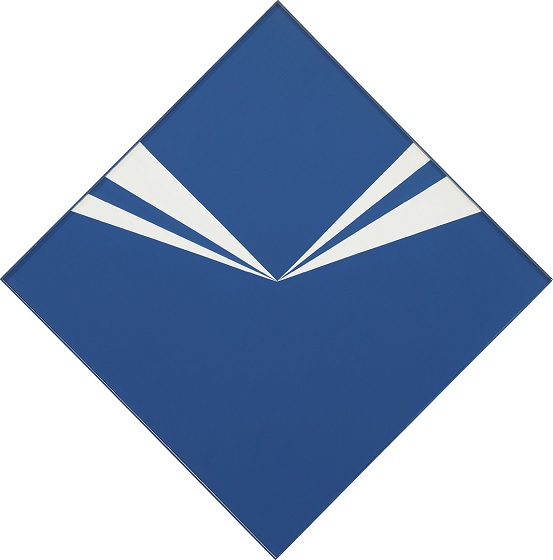
Carmen Herrera, b. 1915
Cerulean, 1965
Acrylic on canvas, in artist’s frame
Crystal Bridges Museum of American Art, Bentonville, AR
In the month of March, the galleries may look at little different, as several works not before seen at Crystal Bridges are being installed. They add to the diverse voices on view in the collection by celebrating different backgrounds, experiences, and styles of the artists represented. Some of these works are by remarkable women artists of the twentieth and twenty-first centuries, including Carmen Herrera and Agnes Martin:

Carmen Herrera at her studio in New York, April 7, 2016. The painter, who turns 101 in May, paints using a method involving small pieces of vellum before an image is transferred to a larger surface. (Todd Heisler/The New York Times) Follow the image link to the NYT story.
Carmen Herrera, Cerulean, 1965
Herrera studied architecture in her native Cuba, but after WWII she moved to Paris where she experimented with abstraction. After moving to New York in 1954—where she has lived ever since—she met American abstract artists and developed her signature geometric style. Herrera, who sold her first painting when she was 89, is still working at age 101!
Coming from an architectural background, the artist is interested in playing with spatial relationships, calling her geometric paintings “a cut in space.” Herrera plays with balance and rhythm through many of her works. In Cerulean, what at first glance seems like a symmetrical painting is actually asymmetrical. Make sure you take a moment to closely examine the white forms coming from the center of the work.
Agnes Martin, Untitled # 7, 1984

Agnes Martin’s work is often viewed as straddling Abstract Expressionism and Minimalism. She imbued her work with significant emotion like Abstract Expressionist painters, but used the simple visual vocabulary of straight lines and grids championed by Minimalists. Martin spent much of her time living in the sparse New Mexico desert. This has been seen as a main inspiration for her restrained approach to artmaking, combined with her interest in Zen Buddhism and Eastern thought, which attempts to reduce distraction in search of beauty and truth.
Untitled #7, like most of her artwork after the sixties, takes the basic grid as a starting point, but here she reduces this form even further, eliminating vertical bands completely. Using soft, subtle colors, Martin intentionally minimalizes the impact of the image, inviting viewers to meditate upon the restrained pattern. This is a work you need to see in person and spend some time with to really appreciate, as the color and line variation are so subtle they don’t translate adequately to a photograph.
These artworks provide two good reasons to come visit the museum’s 1940s to Now Gallery ASAP. But just wait, we’re not done yet! More new works are being installed through the week, and we’ll be talking about them here as they go up. Stay tuned!



